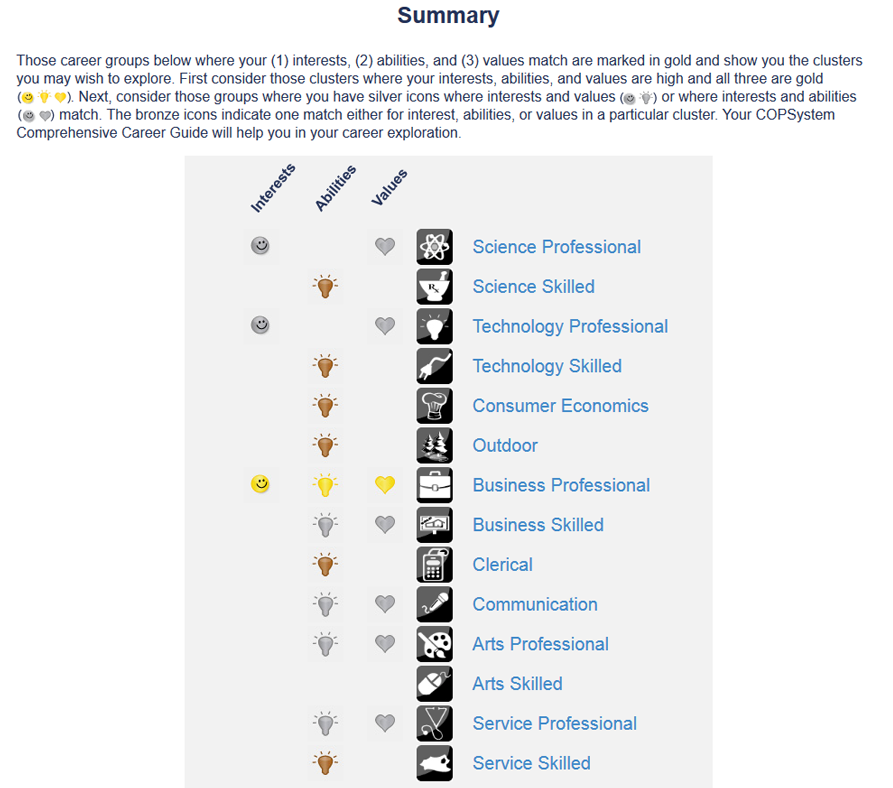
This tutorial is designed to help you interpret the COPSystem results. The COPSystem Summary is designed to provide a visual presentation of an examinee’s results profile for the COPS Interest Inventory, the CAPS ability battery, and the COPES work values survey. The last section is a comprehensive summary that integrates results from all three assessments to provide the examinee with a comprehensive career guidance plan. Please click here to view a complete sample of the results page.
SECTION 1. COPS - INTERESTS
The complete COPS interest profile is shown in Section 1, with a total raw score for each of the 14 career clusters printed immediately to the right of the career cluster title. The raw score ranges from 0 to 27.
A percentile is located at the end of the bar and represents an examinee’s interest level compared to others at the same educational level.
For an interest score of 50, nearly half (or 50%) had a lower interest level on that particular cluster. The higher the score, the greater the interest is as compared to others at the same educational level. Typically, a score of 70% or higher indicates a very high degree of interest in a cluster. Whereas, a score of 25% or lower indicates a significantly lower level of interest.
Occupational Interests – The top three highest interest career groups are presented in the blue box below the COPS profile.
These are the three highest percentile scores on the COPS Interest Inventory profile.
Sometimes a tie occurs among the top three career clusters. In the case of a tie, three career clusters are listed in the order that they appear. If there is a tie for more than three clusters, a review of the COPS Profile should be made with care so that the examinee may evaluate how this finding impacts their career exploration plan.
SECTION 2. CAPS - ABILITIES
This section provides an overview of the two results tables for the Career Ability Placement Survey (CAPS).
The CAPS Career Profile matches an examinee’s ability level to the appropriate COPSystem career clusters. Each of the CAPS tests measure a specific ability that is related to the type of tasks commonly performed in the jobs that comprise each career cluster. This helps examinees identify their strengths and weaknesses in relation to the skills they will need to perform well at work. Each score is represented by either a green or yellow circle. Green scores indicate that examinee will need to improve their ability level to succeed in occupations in that particular cluster.
Job Related Abilities – Plus symbols (+) represent occupational areas that are compatible with an examinee’s skills and abilities and are represented by a yellow circle.
Yellow scores that appear to the right of the shaded boxes in the table receive a plus (+) next to the career cluster that corresponds to that row.
Scores that appear in the upper-bound area of the lightest shaded portion also receive a plus.
When interpreting the profile, concentrate on the distance of the scores from the shaded boxes. The further the score is from the shaded boxes, the greater the likelihood that the examinee’s ability level will enable them to succeed in jobs from that career cluster.
What does a stanine tell me about my ability?
Stanine scores are percentile equivalent scores that indicate how the examinee’s score compares to others at the same educational level. Stanines range from 1-9. Scores from 1 to 3 are below average, 4 to 6 are average, and 7 to 9 are above average. If a score is a stanine 5, which is near the 50th percentile, about half (50 percent) of examinees who took the CAPS scored lower and half scored higher.
The eight CAPS subtests are designed to measure eight independent ability domains. These domains are relevant to a wide variety of jobs and career groups. The COPSystem Career Clusters, include jobs that require different skills and abilities. Therefore, scores from the CAPS subtests are aggregated according to the ability domains that are most relevant to each cluster.
Which CAPS subtests are related to each career group?
SECTION 3. COPES - WORK VALUES
In the COPES profile, scores are represented by bars to the right and left of the midline. Scores falling to the left of the center show strength in values described on the left and scores to the right of center show strength in those values given on the right. Values scores farthest from the center on the left or right represent the most extreme values scores which are then related to the career clusters. The relationship of the COPES values to COPSystem clusters is listed in the "Read More" section of the results page. The COPSystem Comprehensive Career Guide includes a description of each of the COPES values.
The COPSystem Summary section is an integrated summary of interests, abilities, and values. The highest interests, abilities, and values scores are marked with an icon to indicate the career clusters most relevant to the examinee.
Career Clusters with three gold icons should be considered for initial exploration because high levels of interests, abilities, and values have converged, which indicate a high degree of compatibility with jobs that comprise that career group.
Another recommendation is to have the examinee consider career areas that show high levels of interests and values. With additional training over time, areas that show relatively low ability scores may be improved. A convergence of interests and values, as shown by two silver icons, reveals important information that may be used to direct an examinee toward future career options.
Finally, consider the fourth or fifth highest scoring career clusters from Section 1. Occupational interests play a critical role in an individual’s future career choice. By beginning with a broad set of career options, the chances that individuals will benefit from career exploration and the research process increases because they are better able to identify jobs that are compatible with their view of themselves.
The Summary section of the results printout integrates assessment scores from the COPS, CAPS, and COPES. This unique characteristic of the COPSystem allows an examinee to continue the career exploration process with a more holistic understanding of how their own interests, values, and abilities converge in the world of work. A feature of this section is the interactive links from the career clusters to occupational information. When an examinee selects a career cluster they are taken to an information source with a definition of the career cluster, a list of job titles, skills, activities, college majors and related courses. In addition, each job title is further linked to O*Net™.
Needs Assessment – This section lists all of the subject areas in which an examinee indicated they need help or additional information. The Needs Assessment Summary is presented in the form of two questions at the end of the COPS Interest Inventory. Examinees are asked to indicate either a ‘yes’ or ‘no’ to a list of 19 skills given the prompt “I need help in…” the following areas.
Additionally, the COPSystem Comprehensive Career Guide is a valuable resource designed to be used in conjunction with the COPSystem Summary.
This career guide defines each career cluster, lists multiple examples of occupations, including related courses of study, and the skills and abilities required to perform these jobs successfully. Ideas and activities that foster a meaningful career exploration experience are also included in this important reference.











